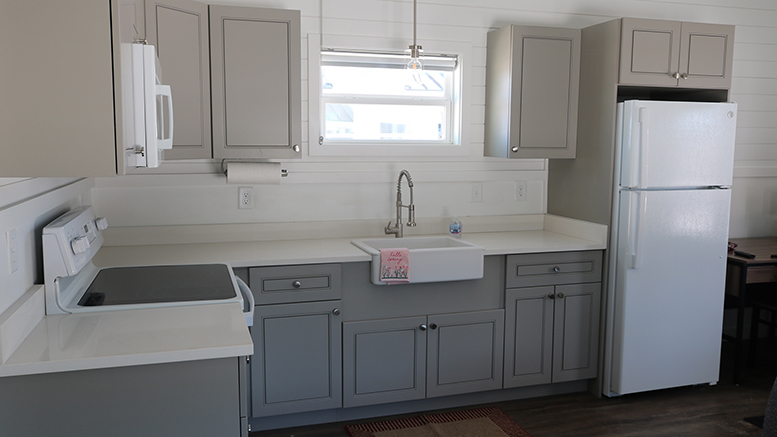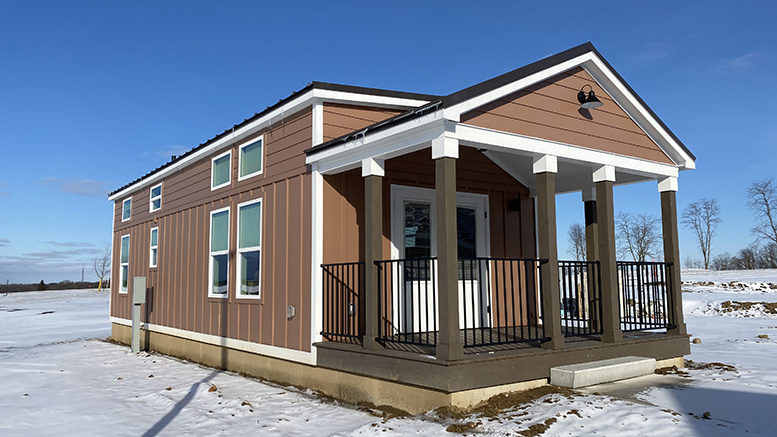Every year, Glenn Richards, director of housing at Jackson College in Michigan, used to get one or two students calling to say they were scheduling their classes, but they would need housing with their children. He would have to tell them, regretfully, that they couldn’t live on campus.
No more. A mother and her son are moving into the first of the college’s tiny homes in time for the second session of the winter semester, which started March 15.
The idea for tiny homes on campus for students with children started in late 2018, when President Daniel Phelan began reading more about the challenges of single parents attending higher education classes. Well over half of those are students are at community colleges, Phelan said, and 90% are low income.
“There was a sector of the student body we hadn’t spent a lot of time with,” he said. “I began thinking, what if we had tiny homes at our college?”
Further research led Phelan to Mustard Seed Tiny Homes in Atlanta, whose mission of tiny homes to prevent homelessness aligned with Jackson College’s values, Phelan said.
Building to code
Phelan soon discovered that no one in Michigan had ever built tiny homes, and the fire and building codes were not set up for them.
“We had to work with licensing bodies in Michigan to allow considerations for fire safety and accommodate Michigan regulations,” Phelan said.
Related article: Housing for homeless students
The college also set up a committee drawn from local agencies that work with those at risk or with disabilities.
“We asked them to help us figure out how to serve single parents or young married folks with children, and to help us select students who will be successful,” Phelan said.
For the families in Jackson’s tiny homes, childcare is available at a daycare center down the street, for children ages two weeks through grade school. An elementary school is across the street, and a middle school is down the road on campus. The college is building a playground with a swing set, slides and a shaded area.
Requirements for residents
Students who move into the tiny homes must sign a two-year rental agreement, with a $425 monthly rent. They must produce recommendation letters and a brief essay explaining why they want to go to Jackson and live on campus. The college will follow these students closely to gauge how the project is working.
“We wanted to set them up for academic success,” said Phelan, who noted that the students have six hours a week of tutoring, plus mentoring for personal leadership.
The tiny homes were custom designed for Jackson. They are about 800 square feet and have different configurations, but all have a microwave, oven, washer/dryer and study area. The homes can fit families ranging from a parent and one child up to a family of five. Larger versions for larger families have a lofted area with three additional beds.
Homes that comply with the Americans with Disabilities Act are on one level and can fit up to three people.

“We need to be careful we don’t impede [families’] ability to take advantage of existing services,” Phelan said. “That’s why we coordinated our effort with local agencies.”
The new program has had several applications.
“We’re using a committee process,” Phelan said, “making sure students are committed to getting an education. We provide them with a job on campus.”
Tiny home residents are required to take summer classes toward their associate degree. If they are interested in earning a bachelor’s degree, Jackson has a partnership with Wayne State University to enable students to do that.
“We’re mindful of students living in cars, trying to raise kids,” Phelan said. With their housing taken care of, “they can focus on academics.”
All the applicants so far have been single parents, said Richards, the college’s housing director. He hopes the five other tiny homes that have been brought to campus will be ready for move-in at the beginning of May, in time for the May 10 start of the spring semester. “If we see success with this, we’ve got plenty of space to build it up – up to 25 tiny homes,” Richards said. “We can create essentially a tiny home village.”


